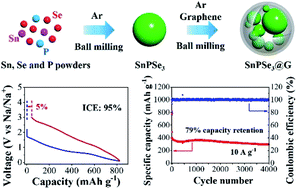A novel multielement nanocomposite with ultrahigh rate capacity and durable performance for sodium-ion battery anodes†
Abstract
Tin (Sn) and phosphorus (P) have been recognized as promising anode materials for high-energy sodium-ion batteries (SIBs) due to their low cost and high theoretical capacity. However, the respective shortcomings of Sn- or P-based sodiation phases, such as low conductivity and large volume change, seriously deteriorate their cycle life and rate capabilities. Herein, for the first time, we have reported a novel multielement SnPSe3@graphene nanocomposite (SnPSe3@G) with outstanding Na-ion storage performance. Its intrinsically good conductivity and the synergistic effect of complementary elements make up for the shortcomings of a single element, enabling fast charge transport kinetics and high structural integrity, which result in prolonged cycling stability and high rate capability. The SnPSe3@G anode exhibits a large capacity of 823 mA h g−1 at 100 mA g−1 with a high initial coulombic efficiency (CE) of 95%, excellent rate performance (362 mA h g−1 at 10 A g−1), and extraordinary ultra-long cycle life (79% capacity retention after 4000 cycles at 10 A g−1). When further combined with an Na3V2(PO4)3/C cathode, the resulting Na-ion full cell exhibits a high energy density of 126.2 W h kg−1 and good cycling stability. This exceptional performance indicates the application potential of multielement synergistic anodes in sodium-ion batteries.



 Please wait while we load your content...
Please wait while we load your content...